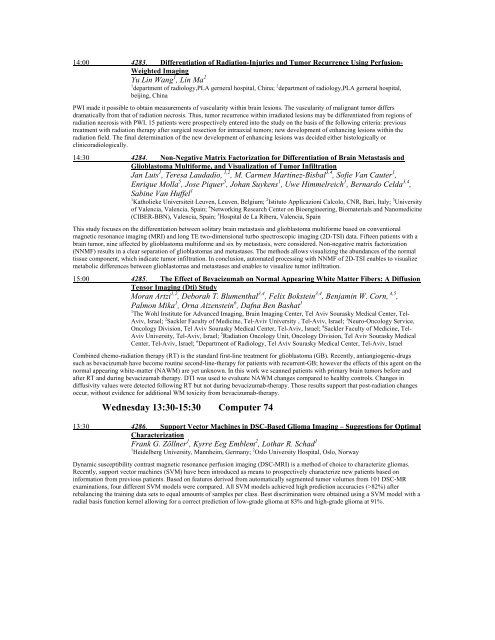ELECTRONIC POSTER - ismrm
ELECTRONIC POSTER - ismrm
ELECTRONIC POSTER - ismrm
Create successful ePaper yourself
Turn your PDF publications into a flip-book with our unique Google optimized e-Paper software.
14:00 4283. Differentiation of Radiation-Injuries and Tumor Recurrence Using Perfusion-<br />
Weighted Imaging<br />
Yu Lin Wang 1 , Lin Ma 2<br />
1 department of radiology,PLA gerneral hospital, China; 2 department of radiology,PLA gerneral hospital,<br />
beijing, China<br />
PWI made it possible to obtain measurements of vascularity within brain lesions. The vascularity of malignant tumor differs<br />
dramatically from that of radiation necrosis. Thus, tumor recurrence within irradiated lesions may be differentiated from regions of<br />
radiation necrosis with PWI. 15 patients were prospectively entered into the study on the basis of the following criteria: previous<br />
treatment with radiation therapy after surgical resection for intraaxial tumors; new development of enhancing lesions within the<br />
radiation field. The final determination of the new development of enhancing lesions was decided either histologically or<br />
clinicoradiologically.<br />
14:30 4284. Non-Negative Matrix Factorization for Differentiation of Brain Metastasis and<br />
Glioblastoma Multiforme, and Visualization of Tumor Infiltration<br />
Jan Luts 1 , Teresa Laudadio, 1,2 , M. Carmen Martinez-Bisbal 3,4 , Sofie Van Cauter 1 ,<br />
Enrique Molla 5 , Jose Piquer 5 , Johan Suykens 1 , Uwe Himmelreich 1 , Bernardo Celda 3,4 ,<br />
Sabine Van Huffel 1<br />
1 Katholieke Universiteit Leuven, Leuven, Belgium; 2 Istituto Applicazioni Calcolo, CNR, Bari, Italy; 3 University<br />
of Valencia, Valencia, Spain; 4 Networking Research Center on Bioengineering, Biomaterials and Nanomedicine<br />
(CIBER-BBN), Valencia, Spain; 5 Hospital de La Ribera, Valencia, Spain<br />
This study focuses on the differentiation between solitary brain metastasis and glioblastoma multiforme based on conventional<br />
magnetic resonance imaging (MRI) and long TE two-dimensional turbo spectroscopic imaging (2D-TSI) data. Fifteen patients with a<br />
brain tumor, nine affected by glioblastoma multiforme and six by metastasis, were considered. Non-negative matrix factorization<br />
(NNMF) results in a clear separation of glioblastomas and metastases. The methods allows visualizing the abundances of the normal<br />
tissue component, which indicate tumor infiltration. In conclusion, automated processing with NNMF of 2D-TSI enables to visualize<br />
metabolic differences between glioblastomas and metastases and enables to visualize tumor infiltration.<br />
15:00 4285. The Effect of Bevacizumab on Normal Appearing White Matter Fibers: A Diffusion<br />
Tensor Imaging (Dti) Study<br />
Moran Artzi 1,2 , Deborah T. Blumenthal 3,4 , Felix Bokstein 3,4 , Benjamin W. Corn, 4,5 ,<br />
Palmon Mika 1 , Orna Aizenstein 6 , Dafna Ben Bashat 1<br />
1 The Wohl Institute for Advanced Imaging, Brain Imaging Center, Tel Aviv Sourasky Medical Center, Tel-<br />
Aviv, Israel; 2 Sackler Faculty of Medicine, Tel-Aviv University , Tel-Aviv, Israel; 3 Neuro-Oncology Service,<br />
Oncology Division, Tel Aviv Sourasky Medical Center, Tel-Aviv, Israel; 4 Sackler Faculty of Medicine, Tel-<br />
Aviv University, Tel-Aviv, Israel; 5 Radiation Oncology Unit, Oncology Division, Tel Aviv Sourasky Medical<br />
Center, Tel-Aviv, Israel; 6 Department of Radiology, Tel Aviv Sourasky Medical Center, Tel-Aviv, Israel<br />
Combined chemo-radiation therapy (RT) is the standard first-line treatment for glioblastoma (GB). Recently, antiangiogenic-drugs<br />
such as bevacizumab have become routine second-line-therapy for patients with recurrent-GB; however the effects of this agent on the<br />
normal appearing white-matter (NAWM) are yet unknown. In this work we scanned patients with primary brain tumors before and<br />
after RT and during bevacizumab therapy. DTI was used to evaluate NAWM changes compared to healthy controls. Changes in<br />
diffusivity values were detected following RT but not during bevacizumab-therapy. Those results support that post-radiation changes<br />
occur, without evidence for additional WM toxicity from bevacizumab-therapy.<br />
Wednesday 13:30-15:30 Computer 74<br />
13:30 4286. Support Vector Machines in DSC-Based Glioma Imaging – Suggestions for Optimal<br />
Characterization<br />
Frank G. Zöllner 1 , Kyrre Eeg Emblem 2 , Lothar R. Schad 1<br />
1 Heidelberg University, Mannheim, Germany; 2 Oslo University Hospital, Oslo, Norway<br />
Dynamic susceptibility contrast magnetic resonance perfusion imaging (DSC-MRI) is a method of choice to characterize gliomas.<br />
Recently, support vector machines (SVM) have been introduced as means to prospectively characterize new patients based on<br />
information from previous patients. Based on features derived from automatically segmented tumor volumes from 101 DSC-MR<br />
examinations, four different SVM models were compared. All SVM models achieved high prediction accuracies (>82%) after<br />
rebalancing the training data sets to equal amounts of samples per class. Best discrimination were obtained using a SVM model with a<br />
radial basis function kernel allowing for a correct prediction of low-grade glioma at 83% and high-grade glioma at 91%.
















